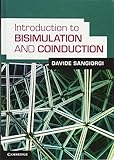Introduction to bisimulation and coinduction /
Material type: TextPublication details: Cambridge ; New York : Cambridge University Press, c2012Description: xii, 247 p. : illISBN: 9781107003637Subject(s): Bisimulation | Coinduction (Mathematics) | Modality (Logic) | Induction (Mathematics) | Computer science | COMPUTERS / Networking / GeneralDDC classification: 004.015 113 Summary: "Induction is a pervasive tool in computer science and mathematics for defining objects and reasoning on them. Coinduction is the dual of induction and as such it brings in quite different tools. Today, it is widely used in computer science, but also in other fields, including artificial intelligence, cognitive science, mathematics, modal logics, philosophy and physics. The best known instance of coinduction is bisimulation, mainly employed to define and prove equalities among potentially infinite objects: processes, streams, non-well-founded sets, etc. This book presents bisimulation and coinduction: the fundamental concepts and techniques and the duality with induction. Each chapter contains exercises and selected solutions, enabling students to connect theory with practice. A special emphasis is placed on bisimulation as a behavioural equivalence for processes. Thus the book serves as an introduction to models for expressing processes (such as process calculi) and to the associated techniques of operational and algebraic analysis"--Summary: "Induction is a pervasive tool in computer science and mathematics for defining objects and reasoning on them. Coinduction is the dual of induction, and as such it brings in quite different tools. Today, it is widely used in computer science, but also in other fields, including artificial intelligence, cognitive science, mathematics, modal logics, philosophy and physics. The best known instance of coinduction is bisimulation, mainly employed to define and prove equalities among potentially infinite objects: processes, streams, nonwell- founded sets, etc"--
TextPublication details: Cambridge ; New York : Cambridge University Press, c2012Description: xii, 247 p. : illISBN: 9781107003637Subject(s): Bisimulation | Coinduction (Mathematics) | Modality (Logic) | Induction (Mathematics) | Computer science | COMPUTERS / Networking / GeneralDDC classification: 004.015 113 Summary: "Induction is a pervasive tool in computer science and mathematics for defining objects and reasoning on them. Coinduction is the dual of induction and as such it brings in quite different tools. Today, it is widely used in computer science, but also in other fields, including artificial intelligence, cognitive science, mathematics, modal logics, philosophy and physics. The best known instance of coinduction is bisimulation, mainly employed to define and prove equalities among potentially infinite objects: processes, streams, non-well-founded sets, etc. This book presents bisimulation and coinduction: the fundamental concepts and techniques and the duality with induction. Each chapter contains exercises and selected solutions, enabling students to connect theory with practice. A special emphasis is placed on bisimulation as a behavioural equivalence for processes. Thus the book serves as an introduction to models for expressing processes (such as process calculi) and to the associated techniques of operational and algebraic analysis"--Summary: "Induction is a pervasive tool in computer science and mathematics for defining objects and reasoning on them. Coinduction is the dual of induction, and as such it brings in quite different tools. Today, it is widely used in computer science, but also in other fields, including artificial intelligence, cognitive science, mathematics, modal logics, philosophy and physics. The best known instance of coinduction is bisimulation, mainly employed to define and prove equalities among potentially infinite objects: processes, streams, nonwell- founded sets, etc"--
| Item type | Current library | Collection | Call number | Status | Date due | Barcode |
|---|---|---|---|---|---|---|
 BK
BK
|
Kannur University Central Library Stack | Stack | 004.015 113 SAN/I (Browse shelf (Opens below)) | Available | 31357 |
Browsing Kannur University Central Library shelves, Shelving location: Stack, Collection: Stack Close shelf browser (Hides shelf browser)

|

|

|

|

|

|

|
||
| 004 WIL/W Web database applications with PHP and MySQL | 004.015 1 BRE/M Modern computer arithmetic | 004.015 1 GAR/D Discrete mathematics: proof techniques and mathematical structures | 004.015 113 SAN/I Introduction to bisimulation and coinduction / | 004.0151 DAV/L Linear Algebra and Probability for Computer science applications. | 004.0151 ZHA/D Discrete mathematics | 004.015193 LEC Lectures in game theory for computer scientists / |
"Induction is a pervasive tool in computer science and mathematics for defining objects and reasoning on them. Coinduction is the dual of induction and as such it brings in quite different tools. Today, it is widely used in computer science, but also in other fields, including artificial intelligence, cognitive science, mathematics, modal logics, philosophy and physics. The best known instance of coinduction is bisimulation, mainly employed to define and prove equalities among potentially infinite objects: processes, streams, non-well-founded sets, etc. This book presents bisimulation and coinduction: the fundamental concepts and techniques and the duality with induction. Each chapter contains exercises and selected solutions, enabling students to connect theory with practice. A special emphasis is placed on bisimulation as a behavioural equivalence for processes. Thus the book serves as an introduction to models for expressing processes (such as process calculi) and to the associated techniques of operational and algebraic analysis"--
"Induction is a pervasive tool in computer science and mathematics for defining objects and reasoning on them. Coinduction is the dual of induction, and as such it brings in quite different tools. Today, it is widely used in computer science, but also in other fields, including artificial intelligence, cognitive science, mathematics, modal logics, philosophy and physics. The best known instance of coinduction is bisimulation, mainly employed to define and prove equalities among potentially infinite objects: processes, streams, nonwell- founded sets, etc"--


There are no comments on this title.